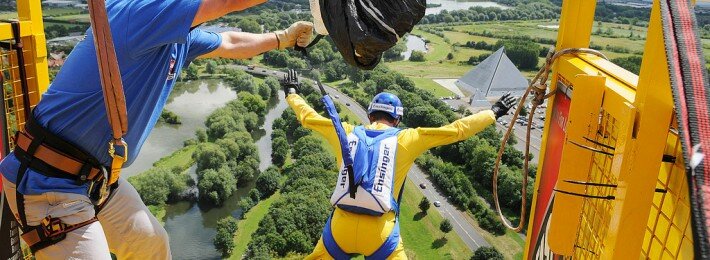Basic Instinct: 10 Stunning Facts About BASE-Jumping
If a prize existed for the world’s most extreme sport, base-jumping might win it. Leaping off some towering landmark – as you do in a base jump – gives you minimal time to adjust for your blind date with the ground, which might go okay if you inflate your parachute fast. The thrill of base jumping is its immediacy – it forces you into the moment. No latitude to plan or agonise about malfunctions. But here’s a lightning brief on the adrenaline sport’s highs and lows.
1. ”BASE”, as it is strictly written, is an ingenious acronym. It nails four kinds of fixed objects from which you can base-jump:buildings, antennas, spans (bridges), and earth (cliffs).
2. The acronym BASE owes its existence to filmmaker Carl Boenish. In 1978, Boenish filmed extreme base jumps from El Capitan: a formidably imposing vertical rock face that stands in Yosemite National Park.
3. Base-jumping requires nerves of steel and a ton of luck. Search for it on YouTube and the video sharing site helpfully feeds you the word “accident”. According to one study, base jumping is one of the world’s riskiest sports, with overall deaths in 2002 estimated at one in 60
participants.
4. Base-jumping has always been dicey. In 1912, pioneer base-jumper Franz Reichelt jumped from the first deck of Paris’ Eiffel Tower. Reichelt, a tailor, was testing his invention, the coat parachute, which needed work. Reichelt’s jump was his last move.
5. Because of base-jumping’s high-stakes drama, action movies routinely riff on it. Way back in 1976, Hollywood stuntman Rick Sylvester skied off Canada’s Mount Asgard for the ski chase sequence that appears in the James Bond film The Spy Who Loved Me. The scene gave the wider world its first glimpse of the ultra-extreme adrenaline
sport.
6. Ambitious base-jumpers with a showman streak enlist global landmarks with maximum wow factor. In 1987, Aussie Steve Dines made the first jump from the top of one of the Southern Hemisphere’s most striking architectural icons: Sydney Harbor Bridge.
7. In 1990, another base-jumper with a sense of theatre, Britain’s Russell Powell naughtily jumped from the Whispering Gallery inside London’s St Paul’s Cathedral. It was the world’s lowest indoor base jump at a reflex-stretching 102 feet. The stunt hit the headlines and annoyed the authorities. Powell, an ex-Royal Marine, avoided winding up behind bars through stating his case intelligently. “St Paul’s is open to the
public and I have not hurt anyone,” he said.
8. Base-jumping is overwhelmingly male. But in 2009, three women – 20-year-old Melody Morin, 28-year-old Venezuelan Ana Isabel Dao, and 32-year-old Norwegian Anniken Binz – base-jumped from Venezuela’s Angel Falls, to spectacular effect. The giant waterfall has a clear drop of 807 metres (2,648 ft).
9. On 8 January 2010, two Emirates Aviation Society members, Nasr Al Niyadi and Omar Al Hegelan, broke the world record for the highest building base jump after plunging from a crane-suspended platform. The platform was attached to the world’s tallest building: Dubai’s Burj Khalifa. The jump-off point was at the 160th floor – 672 metres (2,205 feet) up in the sky.
10. Why base-jump? Because throwing yourself off tall buildings and the like is an incredible buzz and challenge. When they launch into space, base-jumpers say, they are chasing life instead of death. They relish the sensation of flying. Witness the exhilaration. Squirrel suits optional.





Comments